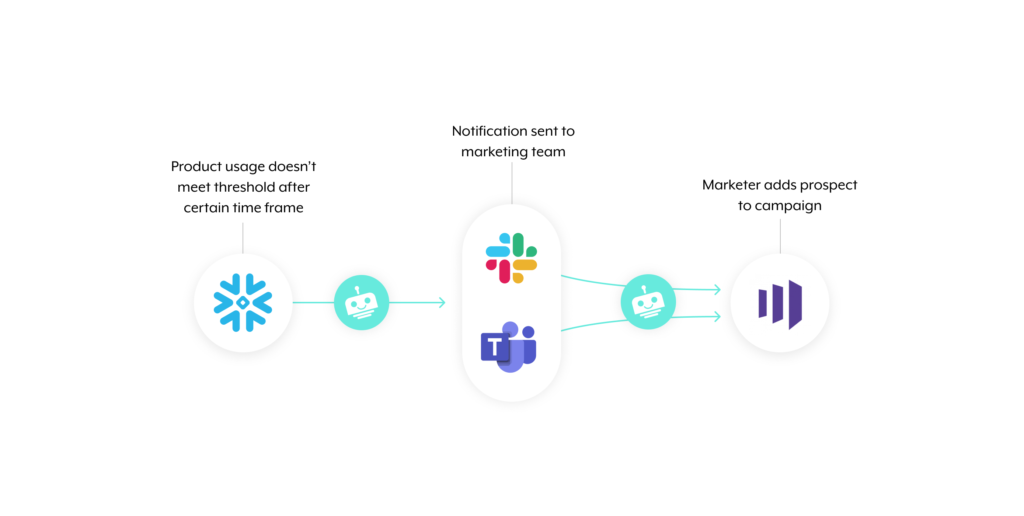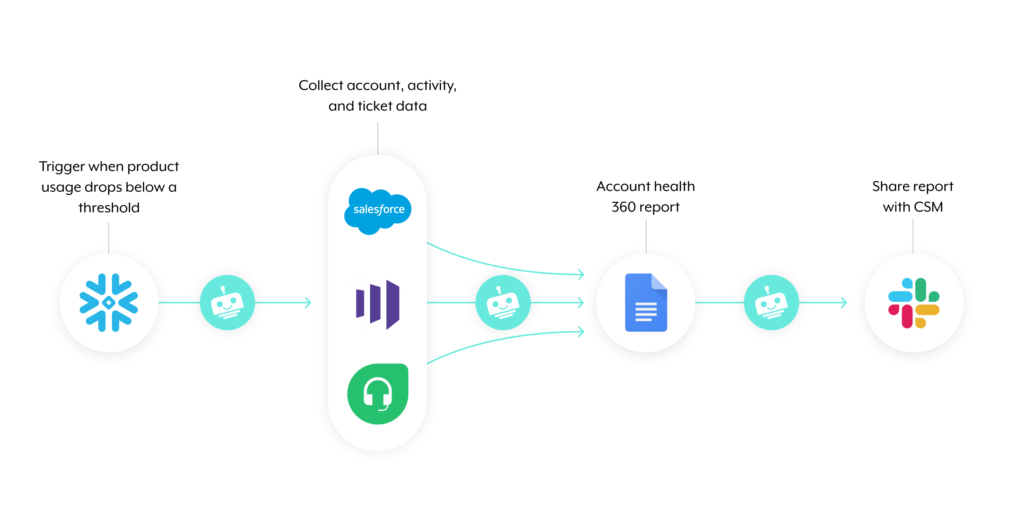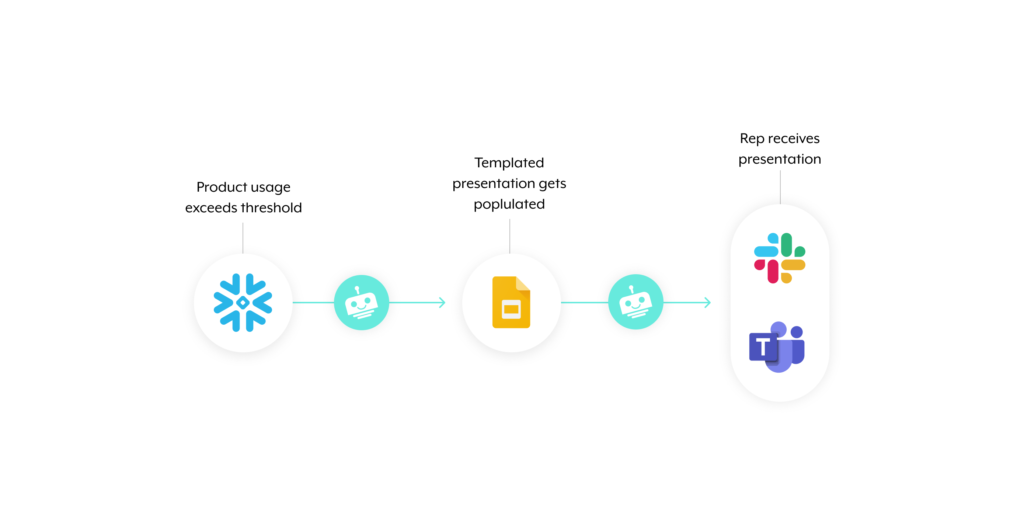An organization’s net retention rate (NRR) is increasingly seen as their north star of success—and for good reason.
It reveals the value your product provides; it demonstrates the quality of your success team; it underscores your position in the market; and it highlights the confidence in your product roadmap.
Improving this critical business metric requires each of your customer-facing teams—from your sales reps to your customer success managers to your marketers—to receive timely and actionable insights based on product usage data. In other words, it requires leveraging product intelligence.
We’ll explain why product intelligence can help fuel your team’s success by breaking down a few examples, but before we do, let’s align on its definition.

Ready to elevate your product-led sales motion?
Learn how account intelligence is key to not only making product usage signals visible but also actionable.
What is product intelligence?
It’s simply the process of collecting, analyzing, and acting on product usage data.
Product intelligence obviously applies to teams that are directly involved in improving the product, such as product designers and product managers; but it can also benefit customer-facing teams. This is especially true when you integrate your data warehouse with the downstream apps they use (e.g. CRM) and implement trigger-based automations that work across these systems.
Note: This definition differs from product analytics, which simply consists of the tools used to collect product data; it also differs from business intelligence, which looks at customer data beyond product usage in order to determine how the customer experience can improve.
Related: What is a customer 360?
Examples of using product intelligence
Let’s walk through a few examples that showcase the value product intelligence brings to customer-facing teams:
1. Notify CSMs in real-time when accounts need attention
Left to their own devices, your customer success managers would struggle to pinpoint which customers need the most support. After all, this requires combing through copious amounts of information in potentially multiple apps.
You can help perform this on their behalf by implementing the following automation:
1. Once a client’s level of product usage drops below a predefined threshold, the workflow gets triggered.
2. A customizable platform bot collects key account information from various customer-facing apps, such as the tickets that users at the account submitted and the users’ recent activities with your team.
3. The platform bot puts all of these insights into a pre-formatted report in a new Google Doc, which then gets shared with the appropriate CSM via their business communications platform. From there, the CSM can move quickly in reaching out to the client in the hopes of improving the relationship.
Related: 3 automations that can lift your customer retention rate
2. Alert your marketing team when a prospect needs additional education
As prospects participate in your free trial, their experiences will inevitably differ from one another.
Some will move quickly in learning how your platform works, and will use it to the fullest extent; while others might get intimidated by the UX, leaving them to ignore your platform shortly after beginning their free trial.
You can help your marketers cater to those who fall in—or closer to—the latter by implementing the following automation:

1. If a prospect’s product usage fails to exceed a certain threshold after a predefined period of time, the workflow gets triggered.
2. A platform bot alerts your marketing team via a specific channel in your business communications platform, where the notification includes information on the prospect from various apps.
3. A member of the channel can add the prospect to the appropriate campaign with the click of a button in the hopes of helping the prospect become more comfortable with the platform—while also increasing the chances that they convert into a client.
Related: How to automate any process
3. Provide reps with presentations for accounts that are ready to spend more
Combing through product data just to identify clients who might be interested in increasing their level of spend (either through an upsell or cross-sell) can prove tedious. Moreover, once the rep manages to identify these clients, they face the daunting task of building personalized presentations that can persuade these clients to spend more.
Fortunately, you can use a single automation to accomplish both of these items. Here’s how it can work:
1. Once a client’s level of product usage exceeds a certain threshold, the workflow begins.
2. A platform bot gathers all of the product usage data on that client—in addition to other types of data—and adds it to the appropriate places within a templated presentation.
3. Once the templated presentation gets populated, the platform bot shares it with the assigned sales rep via a message in their business communications platform; from there, the rep can make minor tweaks to the slides if necessary, study them, and go on to present them to the client when they’re ready.
Why is product intelligence important?
Here are just a few reasons why product intelligence is so critical:
- It benefits various teams. As you can see from our examples, product usage data can help different functions achieve their respective aims; for reps, it’s converting more sales; for marketing, it’s generating more sales-qualified leads; for support, it’s retaining more clients, etc.
- It drives customer-facing employees to action. While making critical information highly visible is important, providing the appropriate next steps can help you get the most from your insights.
Using product intelligence, the leaders in different customer-facing departments can define how their automations operate, which, in turn, influences how their teams behave.
- It delivers improved customer experiences. Perhaps it goes without saying, but empowering success teams to take proactive measures in supporting clients, and enabling sales reps to present clients with the products and services they need, when they need them, lead to experiences that delight clients.
At this point, you might be asking yourself how you’d perform product intelligence. The answer: by using Workato, the leader in enterprise automation. You can read on to learn more about the platform.
Related: What is account intelligence?
Perform product intelligence at scale with Workato
Workato offers a low-code UX, which allows customer-facing teams to build integrations and automations themselves—under the supervision of IT. This ensures that there aren’t bottlenecks in the automation-building process and that the automations are optimized for each team.
In addition, Workato offers:
- Hundreds of pre-built connectors, which include the apps used by customer-facing teams and data warehouse platforms
- Thousands of customizable automation templates to help your team brainstorm and implement automations faster
- Workbot, a customizable platform bot that allows employees to access the data and actions in their apps (that fall within their levels of permissions) inside of their business communications platform, whether that’s Slack or Microsoft Teams.

Want to learn more?
Find out how Workato can help you utilize product intelligence by scheduling a demo with one of our automation experts.


